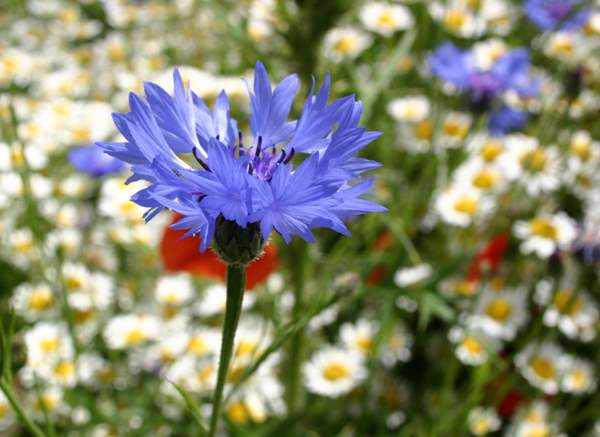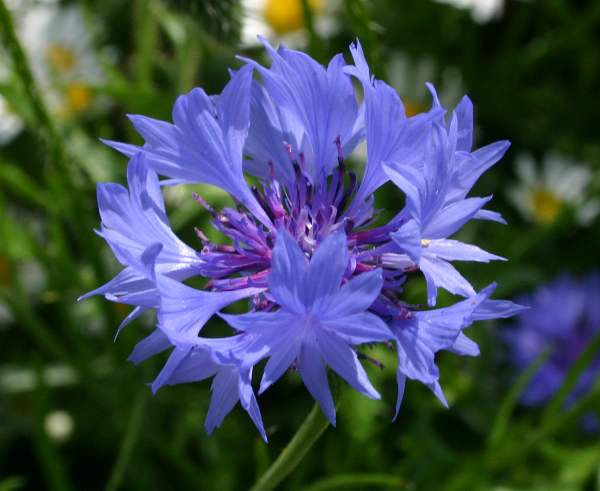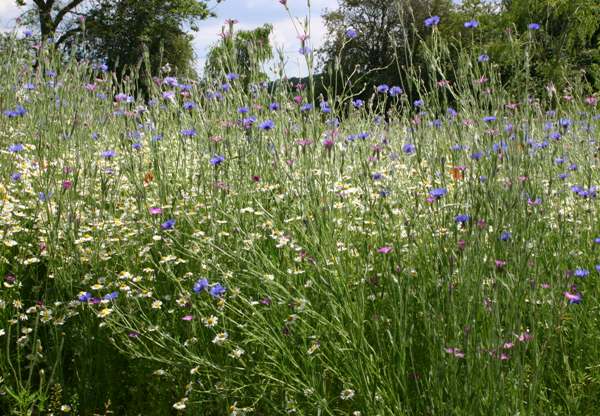Trees Birds Mammals Fish Amphibians Reptiles
Wild Algarve
Bookshop
Centaurea cyanus - Cornflower
Phylum: Magnoliophyta - Class: Equisetopsida - Order: Asterales - Family: Asteraceae

This annual wild flower, a close relative of the knapweeds, grows up to 0.8m in height with tough, greyish-green loosely branching stems and lanceolate leaves up to 4cm long. What makes the Cornflower such a memorable sight is the intense blue of its flowers, which like other members of the Daisy family comprise a cluster of central disc florets (these are more of a violet blue) surrounded by an unusually small number (typically 12) of ray florets. The ray florets are pure blue and widely spaced, with a trumpet-like appearance.

Distribution
Cornflowers were once very common on wasteland and on arable farmland in Britain and Ireland. The use of agricultural herbicides has virtually eradicated this beautiful wildflower from the British landscape, and it is now only seen if seed has been deliberately spread.
In some parts of southern Europe where intensive farming regimes have not yet been adopted it is still common to see cornfields flushed with bright blue and scarlet due to the presence of Cornflowers and Common Poppies. These wildflowers may be no good for cattle fodder, but they are excellent food for the human spirit!
Centaurea cyanus is also found in many parts of North America, where it is a naturalised introduced species and, as in Europe, a very popular choice for growing from seed in parks and gardens.

Habitat and Blooming Times
In Britain and Ireland Cornflowers grow wild in just a few cornfields where the land is not subjected to heavy doses of 'weedkiller' and artificial fertilliser; there are also odd patches of 'wasteland' where cornflowers still grow wild. For the most part, however, where you see Cornflowers in a wildflower meadow in Britain or Ireland they will have been grown from 'wildflower seed mixtures'. Rarely do such meadows maintain their brilliance for more than a year or two before they need topping up with more introduced seeds; even so, a planted Cornflower meadow is a wonderful sight. (The meadow pictured above, in Hampshire, England, is a fine example of what can be achieved.)
Cornflowers bloom from late June until the first frosts of autumn, and in southern Britain, where the last few truly self-sustaining populations are, they are usually at their best in July.
Similar Species
A close relative, Centaurea montana, is a creeping perennial that is often grown in parks and gardens.
Etymology
Centaurea, the genus name, comes from the Centaur Chiron, who used the flowers of this plant as a poultice to cover a festering wound made by an arrow dipped in Hydra's blood, The wound was cured and so, the story goes, Cornflowers were given the name Centaurea. The specific epithet cyanus refers to the bright blue of the flowers, of course.
Sue Parker's latest ebook is a revised and enlarged edition of Wild Orchids in The Burren. Full details here...
Buy it for just £5.95 on Amazon...
Sue Parker's new ebook is a comprehensive and fully revised edition of her acclaimed field guide to the Wild Orchids of Wales. Full details here...
Buy it for just £5.95 on Amazon...
Please Help Us: If you have found this information interesting and useful, please consider helping to keep First Nature online by making a small donation towards the web hosting and internet costs.
Any donations over and above the essential running costs will help support the conservation work of Plantlife, the Rivers Trust and charitable botanic gardens - as do author royalties and publisher proceeds from books by Pat and Sue.